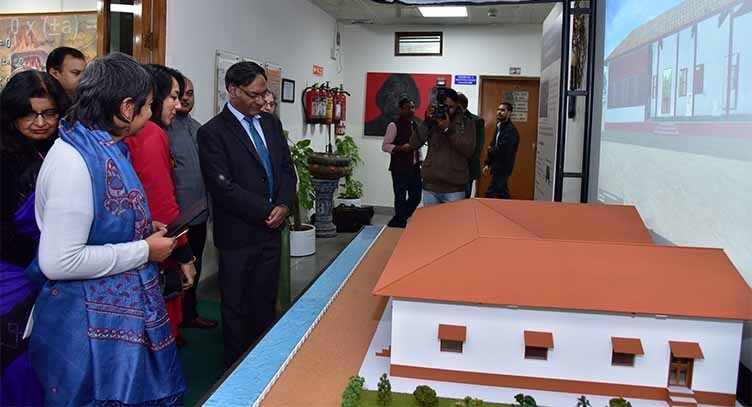
Phase-II of the Digital Gandhi Gyan Vigyan Exhibition was launched on the occasion of Martyr's day on 30th January 2020, showcasing Augmented Reality (AR) and Virtual Reality ( VR) based new exhibits related to the life of Mahatma Gandhi. The Exhibition, titled Digital Gandhi Gyan Vigyan Exhibition Phase-II, was inaugurated by Prof. Ashutosh Sharma, Secretary, Department of Science and Technology (DST) at Technology Bhavan, New Delhi.
Inaugurating the Exhibition, DST Secretary Prof. Sharma said that such technologies would make his thoughts, life events, and places alive in different media as inspirations to a world increasingly focused on sustainability.
“Technology ought to be an enabler for conveying content more effectively. Media keeps changing with times, and this march of media and technology would not stop. It has been 150 years since he was born, if we were doing 200th year of Mahatma Gandhi fifty years from now, you would most likely interact with Gandhiji as a humanised robot or at least as a very realistic hologram powered by AI.” he added.
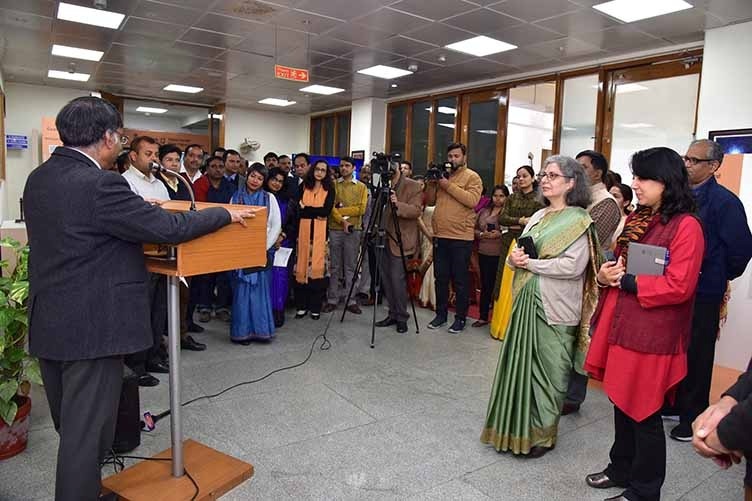
“However, in this march of media and technology, we should remember that technology is a medium for us to transfer what is more essential. Not to be carried away simply by technology and to focus on the essence is a very difficult task, and it is a very fine balancing act,” Professor Sharma pointed out.
To commemorate the 150th birth anniversary of Mahatma Gandhi, DST installed Augmented Reality (AR) and Virtual Reality (VR) based exhibits to showcase the events related to the life of Mahatma Gandhi. The Phase-I of the Digital Gandhi Gyan Vigyan Exhibition was launched on 2nd October providing virtual reality experience to the visitors on the life of Gandhiji, with special focus of his life at the Sabarmati Ashram and a fabricated physical model of a Charkha which gets animated when seen through an AR App on a hand-held device such as a smart-phone or tablet.
New exhibits displayed during Phase-II of the Digital Gyan Vigyan Exhibition include ViRaasat Sabarmati Ashram, AR Experience of Gandhiji’s utensils, his letters, his travels, 3D Printed Gandhi Mementos (Statue and Signatures) augmented with an AR App.
Mrs. Anju Bhalla, Joint Secretary, DST, urged school children and staff members to visit the Exhibition and learn from Gandhi Jee’s life using technology.
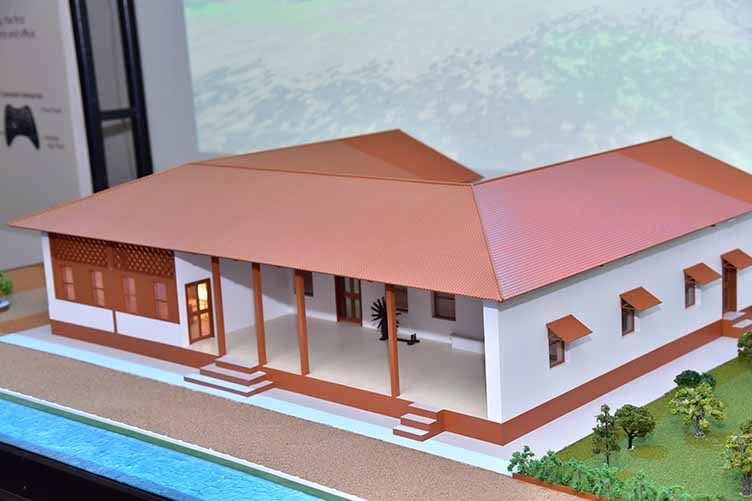
Phase-II of Exhibition has been launched in collaboration with Vizara Technologies Pvt. Ltd, Delhi, a technology start-up under the incubation of IIT Delhi. Vizara Technologies is instrumental in providing the exhibits for the Phase-I of the Digital Gandhi Gyan Vigyan Exhibition, and they have also implemented four projects of ICPS Division on Augmented Reality and Virtual Reality in IIT Delhi.
The following five Exhibits which will be showcased in the “Digital Gandhi Gyan-Vigyan Exhibition- Phase II” in the DST Office at Technology Bhavan:
1. ViRaasat Sabarmati Ashram
This is a mixed - reality installation with a 3D fabricated physical model and an interactive Virtual walk-through of the Gandhi Sabarmati Ashram at Ahmedabad. The Ashram is situated next to the Sabarmati River and has many iconic, historic buildings. The installation called a ViRaasat installation is housed in a kiosk of size 8 ft X 4 ft X 9 ft and is composed of the following:
- A Table to place the 3D fabricated model. In “ViRaasat Sabarmati Ashram”, the model placed on the table is of Hriday Kunj, Gandhiji’s home and office at the Sabarmati Ashram. It shows the different rooms and even some of Gandhiji’s possessions.
- A Screen behind the table to project the Virtual Walk-through of the Sabarmati Ashram, interactively controlled through a Game Controller and a Tablet.
- Projectors for projection on the model and the screen.
- Graphics workstation to render the Models and run the computer graphics software.
Users can interactively and virtually explore the Sabarmati Ashram using the game controller. They can also watch a guided virtual tour of the Ashram.
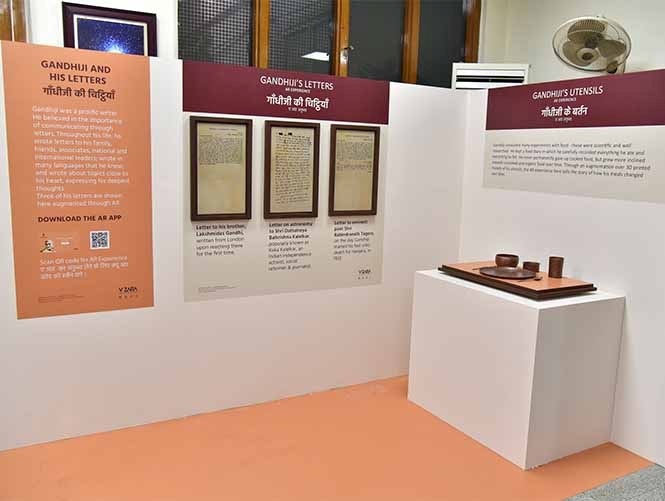
2. Gandhiji’s Utensils AR Experience
3D printed models of Gandhiji’s Utensils with an AR experience showcasing his experiments with food, his changing food habits over time and the science behind his food choices. Gandhiji conducted many experiments with food - these were scientific and well researched. He kept a food diary in which he carefully recorded everything he ate and everything he felt. He never permanently gave up cooked food but grew more inclined towards uncooked and organic food over time. Through an augmentation over 3D printed models of his utensils, the AR experience here tells the story of how his meals changed over time.
Users can download and install the app “Digital Gandhi Gyan Vigyan” from the Google Play store on their Android Smartphones to experience the AR over the Utensils.
3. Gandhiji’s LettersAR experience
Gandhiji was a prolific writer. He believed in the importance of communicating through letters. Throughout his life, he wrote letters to his family, friends, and associates, national and international leaders. He wrote in many languages that he knew and about topics close to his heart, expressing his deepest thoughts. Three of his letters are shown in this exhibit augmented by an AR experience through the mobile AR app “Digital Gandhi Gyan Vigyan”, to be downloaded from the Google play store.

4. Gandhiji’s Travels AR Experience
Mahatma Gandhi travelled across the length and breadth of India, inspiring people everywhere. This AR experience shows some locations and their connection with Mahatma Gandhi. A Physical map of India is shown in this exhibit augmented by an AR experience through the mobile AR app “Digital Gandhi Gyan Vigyan”, to be downloaded from the Google play store.
5. 3D Printed Gandhi Mementos (Statue and Signatures) augmented with an AR App.
One of the mementos is a 3D printed statue of Mahatma Gandhi in a walking posture with a 3D printed model of his signature in English. The replica is made by using a 3D scan model of the Statue of Mahatma Gandhi located at the entrance of the Canadian Museum for Human Rights in Winnipeg, Manitoba. The original sculpture was created by renowned Indian sculptor Ram Vanji Sutar. This sculpture exemplifies Mahatma Gandhi’s ideals of peace, justice, simplicity, minimalism, and relentless action-oriented determination to achieve his goals – one of them being the independence of India. The replica is 3D printed in PLA, a bio-degradable plastic material, using additive manufacturing.
The smaller memento is a 3D printed replica of the English signatures of Mahatma Gandhi along with a line drawing of him in a walking posture.
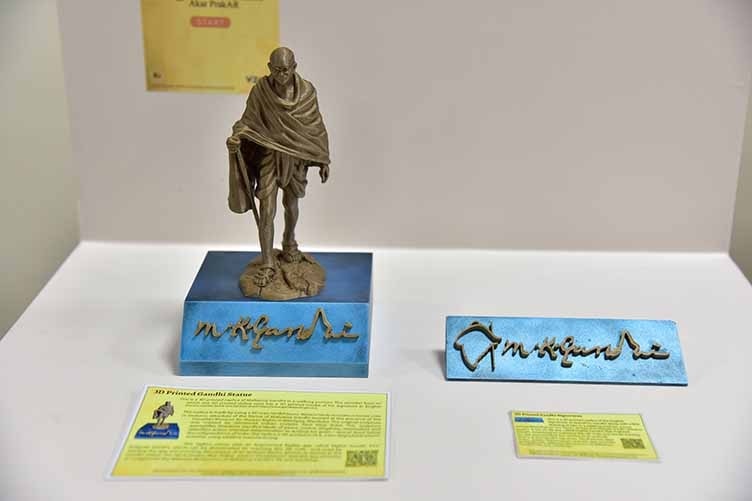
Both these mementos come with an Augmented Reality app called Digital GandhiAkar PrakaAR, which can be downloaded from Google Play Store and used by starting the app and pointing the camera of an android device (phone or tablet) at the Gandhi statue or signature. The Hindi phrase Akar Prakar means Dimensions, and this app provides an insight into the different dimensions of Mahatma Gandhi’s life and teachings.






























